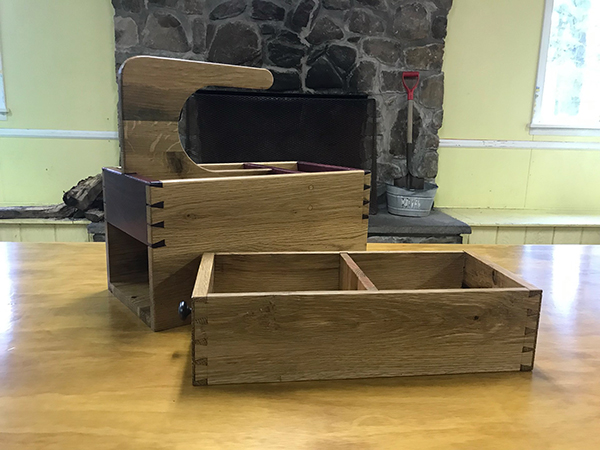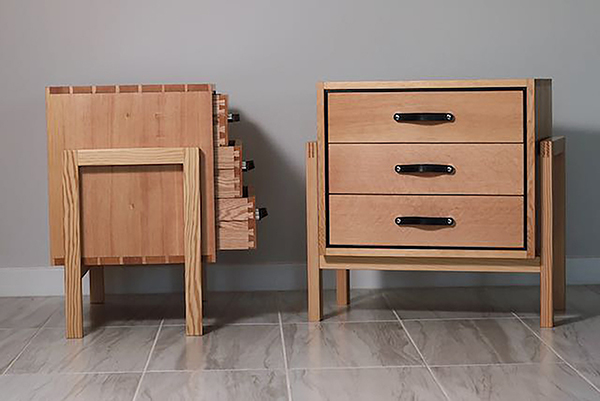
Last week, Chris wondered what your thoughts are about all things dovetail. Here’s what’s come back in our mailbag! — Editor
“I learned how to hand-cut dovetails when I was 16 and worked with my dad in the mid 1970s. I was taught that instead of buying an expensive jig that only did one job in the shop, take an extra 30 minutes or so and hand-cut them instead. To this day, I make all my drawers with hand-cut dovetails, and after 50 years and hundreds and hundreds of drawers and boxes I have never thought about using a jig. The extra time it takes to lay out and cut is shop time in my happy place.” – Rick Smith
“Dovetails are part of nearly everything I make anymore. I use hand tools for this task to save dust and noise while acquiring more skill with the tools.” – Denny Lawson
“I have used my first-generation Rockler jig to make dovetails when I want them. Mostly half-blinds for drawers, but like you, I will occasionally use them to create interest on a piece that needs something extra. I have always wanted to try hand-cut dovetails, but I have not taken that step. A friend who has taught classes in hand-cut dovetails assures me that it’s pretty easy, but he’s shifty.” – Rob Hahn
“I have attempted to cut dovetails with somewhat satisfactory results. I purchased a dovetail jig from Peachtree Woodworking several year ago, and it cuts flawless dovetails. This jig makes dovetail cutting simple and precise.” – Dennis Sheehan
“Years ago, I built a toy box for my granddaughters and decided to use dovetail joints. I hand-cut all of them over a period of a week. In my opinion, they turned out pretty good for my first time cutting them. I only had to adjust the fit on three or four. The toy box is still in use after 10 years and still in good shape.” – Samuel Lytle
“I use dovetails a lot on my projects. I do a lot of design and build in the field of medium to large size furniture projects. I’ve been into woodworking since retiring from the electrical industry in 2009. I do all my dovetails by hand. I’ve tried to do dovetails on the table saw but screw up more than I do by hand. I’ve slowed way down on my projects the last few months due to cancer of the esophagus. My surgeon has given me two years to live. I intend to make a liar of him. It’s been my goal for years to live to the age of 106.” – Bill Self

“I made the ‘Gluing Supplies Caddy’ that appeared in the February issue of Woodworkers Journal(see above). I wanted to try to increase my novice skills of hand-cut dovetails. I watched YouTube videos from Rob Cosman on through dovetails, half-blind dovetails and his three video series on drawers. I made some mistakes along the way, which I learned from. Although I made some mistakes, mostly in not cutting the tails square enough to the board, the caddy turned out good. I am happy with the finished project. I used white oak that my father-in-law milled from trees he and my mother-in-law felled when they cleared their lot to build their home. I used purpleheart I had on hand for the pin boards. I built the drawer 4-5/8″ high because I wanted 4-1/8″ of height from the top of the drawer bottom to the top of the drawer. It was a little tricky getting the drawer to slide freely so it could open in both directions. Planing a little off the interior sides of the carcass with my 5-1/2″ bench plane and a skew block plane solved that problem. I finished it with satin polyurethane. I then hand-rubbed it with 0000 steel wool, Rockler pumice stone, Rockler rotten stone and paste wax.” – George Maehrer
“Dovetails are beautiful and always fascinated me, yet for many years they remained intimidating. Finally one winter, I decided to give them a try and cut my first attempt in a couple pieces of scrap 1″ x 2″. The resulting dovetails were crude yet surprisingly strong and effective. That gave me the bug and encouragement to try again. I needed a basic workbench in my garage and asked a local contractor to let me know the next time he did a kitchen cabinet upgrade for someone. He called while I was out shopping and said he had left a couple cabinets in my driveway and to let him know if I wanted them or not. There were several cabinets with plenty of countertop, one being 16 ft. long. I thanked him and paid what he asked, which was a pittance compared to new prices. A couple drawers were missing, which became the perfect time to make some new ones using dovetails. Not having a workbench with the big open vise, I built a Moxon vise and clamped it to the wing of my table saw. Then I read and watched YouTube videos on dovetails until I was comfortable with the marking, hand sawing and chiseling process. Taking my time to get them right, the dovetails came out very good. They still have a little gap here and there, but glued up tight and are perfect for a garage cabinet. It has been a couple years since then, but I am no longer scared of the process and will definitely cut more when the need arises for drawers, boxes or wherever they may make a good impression in a project.” – John Eickstadt
“I have cut dovetails for years. Like many, I cut my first dovetails as a test of my skill level. The joint was the appropriate one for the project — a toolbox. My first dovetails were cut by hand, and I still prefer that method. I have cut them with a jig—half-blind (Porter-Cable 12″ jig). Once I figured out how to lay them out quickly, I could cut through dovetails faster than I could with a jig. They look better and are quicker. (The fussiness of getting a jig set up, doing test cuts and so forth takes a lot of time and material that I prefer to use in a different way). My focus for the last several years has been making boxes on commission and for friends and family. Dovetails are strong and beautiful. If another joint is more appropriate, I use that joint (like the mortise-and-tenon frames around the Kumiko panels). If you were really interested in generating a buzz, you would have asked whether we cut pins or tails first. (And there are brilliant and opinionated practitioners of each approach.)” – Rusty Farrington
“I have made box joints with help of commercial jigs on the table saw and with a router, as well as dovetails with a router table jig. To me, getting them set up to fit and look great gives similar satisfaction to what I might have gotten by hand-cutting dovetails. I have thought about trying to hand-cut the dovetails several times, but I always found a new technique to learn that was more interesting to me.” – Jim Thorp
“On small projects with few joints, I use dovetails cut by hand because it is faster than setting up machines and making/measuring samples. They usually enhance the strength and appearance as well. I suspect in the days before corded tools, they were the easiest way to make consistently strong joints and appearance enhancement came along later. On projects with a lot of drawers, I may set up a router jig (Rockler) and cut them that way. I only use finger joints where the product’s appearance is enhanced by them. While long-grain glue surfaces make them strong, setup accuracy is critical because errors compound over long joint spans. (And once the setup is perfect, they are extremely boring to make in quantity.) Miter joints are reserved for joints where material height or product appearance (grain continuity, etc.) necessitates them. Their lack of strength makes them inappropriate in many applications unless reinforced internally with splines or biscuits, or externally with inside braces, gussets, etc. (more work and time).” – Ernie
“What an interesting question. I am, I suppose, what you could call a hybrid woodworker. When I first began woodworking, I was taught how to cut dovetails (tails first) in a class where I was being instructed on the construction of a nightstand (I was actually building a sewing cabinet for my wife that incorporated a hinged flush top with swing out leg supports.). I eventually bought a 12″ half-blind dovetail jig and, with practice, was able to turn out good-looking half-blind dovetails. I eventually took a class to construct a chest of drawers. Having long been a fan of campaign-style furniture, I decided to design and build a campaign secretary (with the help of Christopher Schwarz’s book). I was (and am) in possession of quite a stack of camphor lumber that I got from felling a tree in my front yard. The milling of which resulted in a number of 8/4 slabs in widths of 26 inches and less. I was able to mill the slabs into the 18″ boards I needed for my carcasses. I decided to use through dovetails at the corners of each carcass. I first attempted to use a Porter-Cable jig owned by the school, but it proved more than a little recalcitrant to keep the spacing repeatable. Fortuitously, I found and purchased a Leigh DR-4, 24″ jig; and, with the purchase of few replacement parts was able to complete the eight sets of dovetails required for the project. I plan on using box joints for the parts of the secretary that will reside within the top half. I have hand-cut through dovetails on some small projects, mostly boxes to hold tools, as the camphor is also somewhat rust preventative. I have never hand-cut half-blinds. To sum up, I would wholeheartedly recommend the Leigh jig for its spectacular versatility and an instruction manual that is the best I’ve ever seen. As old as my jig is, there are still parts available and a kit so that it can be upgraded to a DR4-PRO.” – Ralph Loimbardo
“When I was taking woodworking classes at Ivy Tech University in Kokomo, Indiana, a fellow student wanted to make a cabinet with hand-cut dovetails. He spent the entire semester working on those dovetails, while I was working on a project with drawers. At the end of the semester he still hadn’t completed his project. I used the P-C dovetail jig for my dovetails and finished in one class. Unless you’re very skilled at making dovetails by hand, I personally think it’s a waste of time. With excellent dovetail jigs, why spend hours or days doing it by hand?” – Carol Johnston
“I’ve been woodworking for over 40 years. My philosophy on dovetails is to use them as much as possible, as they are one of the strongest joints. For kitchen cabinets or utilitarian uses, I use machine-made dovetails with a Porter-Cable template and router. For fine woodworking, usually one-offs, I make hand-cut dovetails. They both have their challenges for getting it right.” – Tracy Novak
“I build furniture in my shop primarily. Most pieces have one or two small drawers. I will hand-cut those, since I can get them done before my jig can even be set up. When I built an apothecary chest for my wife’s friend, I broke out the Rockler dovetail jig and knocked out the 30 odd drawers in a couple hour’s work. Hand-cutting dovetails is easier than many think; it does take some practice to get good, but it helps me feel connected to my craft when I do it. Sort of a rite of passage.” – Ralph Bagnall

“I thought I’d share my experience with dovetails and my journey that started back in the 70’s with woodwork. I taught woodshop at the middle-school level and have always been inspired by what people can do with their own hands, tools and dedication to the craft. Right or wrong, dovetails have always been the supposed ‘hallmark of craftsmanship.’ To me, they’ve always been the epitome of quality work and I know that’s subjective. That being said, cutting and fitting them by hand is the only way to go. In my early commission work, I’d bang them out with a Craftsman jig and router but was never really satisfied with the results. Magnetic guides to hold the saw are more of a crutch; I feel you should work on your muscle memory to achieve the joint. I’m into my seventh decade now and my vision isn’t what it was, but I find with enough light I can still cut to the line. I’ve never followed the adage that time equals money; instead I like the adage that time equals care! As I recall, one of the great woodworkers of the 70’s and 80’s said that, maybe Krenov or Carpenter. So, there’s my old-school response! Here’s a photo of my latest project — a pair of nightstands built from vertical-grain Douglas fir. There is a total of 104 dovetail joints in them. I remember the Doug fir being pretty stringy and not reacting well to chisel and dovetail saw, but that’s all part of the challenge! CNC may be perfect but lacks soul; I like the saying about the beauty of an object created by hand is its imperfections!” – John G. Eugster
“Dovetails are wonderful, not only because they are beautiful but also because of the mechanical strength they bring to the joint and therefore the piece. I use them every time it makes sense. I do all mine by hand (just like I do everything else).” – Edward P. Leonard
“I am a self-taught woodworker and I have yet to teach myself how to make dovetail joints. It is on my bucket list! I hope this is the year for that to happen. When I was a teen in high school, girls were forbidden to take any type of ‘shop’ class. My love for woodworking was inherited from my dad who had NO electric carpentry tools. He did everything with hand tools. I only wish he lived long enough to teach me. If I ever win the lottery, I will buy the best woodworking tools and will build a workshop dedicated to ‘all things related to woodworking’…every gal’s dream!” – Janice L. Olson
“The only time I have cut dovetails is when repairing a piece of furniture. Since I was trying to match an existing piece, it was easiest to hand-cut the replacement. Back in the days when hide and fish glue were about the only choices, the dovetail made a lot of sense. With modern adhesives, there are stronger ways to join wood that are, in my opinion, also more functional and — dare I say it? — attractive.” – Eric Patchke
“I use a Leigh D4. It’s an older one and I hate it. I’m 81 years old, and the directions aren’t easy. Also they come with the machine, but they’re on VHS.” – Jim Thomas
“Machine-cut with a Leigh D4R jig. Love the look on drawer boxes and other exposed joinery like the case of a chest of drawers or a dresser base. Don’t feel I can cut them as precisely by hand, and my aim is for good looks over proving I can hand-cut a dovetail! And it’s so much faster with a router and the jig.” – Frank Baltich
“I do not use dovetails. More show than go.” – Tom Triola






